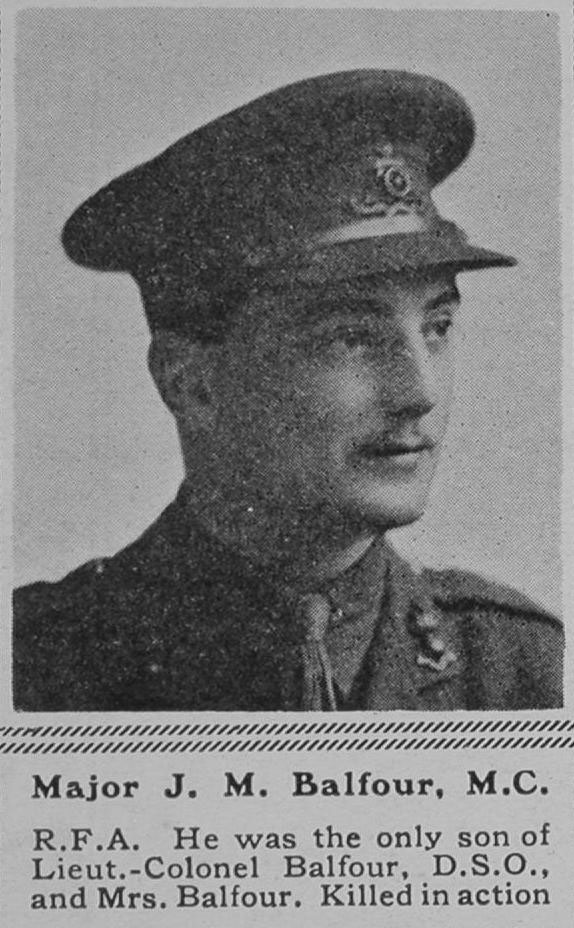Maj.
John Melville Balfour
Information about birth
|
Date of birth: 07/03/1894 |
|
Place of birth: Eastbourne, Sussex, England, United Kingdom |
General information
|
Last known residence: Bristol, Gloucestershire, England, United Kingdom |
|
Religion: Church of England |
Army information
|
Country: England, United Kingdom |
|
Force: British Expeditionary Force |
|
Rank: Major |
|
Units: — Royal Field Artillery, "C", 91st Brigade (Last known unit) |
Information about death
|
Date of death: 06/10/1917 |
|
Place of death: Ruisseau Farm, Belgium |
|
Cause of death: Killed in action (K.I.A.) |
|
Age: 23 |
Cemetery
|
Canada Farm Cemetery Plot: III Row: D Grave: 7 |
Distinctions and medals 4
|
1914 Star Medal |
|
British War Medal Medal |
|
Military Cross Medal |
|
Victory Medal Medal |
Points of interest 3
| #1 | Place of birth | ||
| #2 | Last known residence | ||
| #3 | Place of death (approximate) |
My story
John Melville Balfour was the only son of Lieutenant Colonel Arthur Mackintosh Balfour and Florence Cecilia Elizabeth Craig. He was born on 7 March 1894 in Eastbourne, Sussex. Arthur and Florence later had two daughters as well. In 1911, John found himself in Bristol, Gloucestershire where he attended school at Clifton College as a 17-year-old. He followed in his father's footsteps and chose a military career. On 15 August 1914, at the age of 20, he disembarked as 2nd Lieutenant with the 117th Battery, 1st Division. He was later transferred to the C-Battery Royal Field Artillery (91st Brigade, 20th Division) where he was a captain but acted as a major. On 4 June 1917, he received an entry in the London Gazette as a recipient of a Military Cross.
John died on 6 October 1917. Two days earlier, on 4 October 1917, the Battle of Broodseinde, part of the Battle of Passchendaele, took place. During that battle, the 91st Brigade was near Canal Bank. They were part of the 11th Division's successful attack between the Menin Road and the Ypres-Staden railway, aiming, among other things, to take the village of Poelcapelle. On 5 October, 20th Division received orders to cover the Guards Division. They took up positions along the Steenbeek near Ruisseau Farm near today's Melkerijstraat. The batteries worked all day to build a road around shell-holes. The actual positions were along the riverbank in very difficult ground. Around 7pm, the 91st Brigade started the advance, but there was a lot of confusion on the road due to the presence of other units and German shelling of the road which slowed down the advance. The brigade's advance was successful, but they only managed to put four rifles and two howitzers into action due to the wretched state of the ground.
One of those guns was being operated by 23-year-old Major John Melville Balfour when he was fatally hit by a shell. He was buried in Canada Farm Cemetery (III, row D, grave 7).
John died on 6 October 1917. Two days earlier, on 4 October 1917, the Battle of Broodseinde, part of the Battle of Passchendaele, took place. During that battle, the 91st Brigade was near Canal Bank. They were part of the 11th Division's successful attack between the Menin Road and the Ypres-Staden railway, aiming, among other things, to take the village of Poelcapelle. On 5 October, 20th Division received orders to cover the Guards Division. They took up positions along the Steenbeek near Ruisseau Farm near today's Melkerijstraat. The batteries worked all day to build a road around shell-holes. The actual positions were along the riverbank in very difficult ground. Around 7pm, the 91st Brigade started the advance, but there was a lot of confusion on the road due to the presence of other units and German shelling of the road which slowed down the advance. The brigade's advance was successful, but they only managed to put four rifles and two howitzers into action due to the wretched state of the ground.
One of those guns was being operated by 23-year-old Major John Melville Balfour when he was fatally hit by a shell. He was buried in Canada Farm Cemetery (III, row D, grave 7).
Sources 8
|
91 Brigade Royal Field Artillery (The National Archives, KEW (TNA), WO 95/2105/4_03). https://www.nationalarchives.gov.uk/ Sources used |
|
British Army World War I Medal Rolls Index Cards, 1914-1920 (The National Archives, Kew (TNA), WO 372). https://www.nationalarchives.gov.uk/ Sources used |
|
British Army World War I Service Medal and Awards Rolls, 1914-1920 (The National Archives, Kew (TNA), WBO 329). https://www.nationalarchives.gov.uk/ Sources used |
|
Census Returns of England and Wales, 1901 (The National Archives, Kew (TNA), RG13). https://www.nationalarchives.gov.uk/ Sources used |
|
Census Returns of England and Wales, 1911 (The National Archives, Kew (TNA), RG14). https://www.nationalarchives.gov.uk/ Sources used |
|
East Sussex, England, Church of England Births and Baptism,1813-1920. par 317/1/2/1. https://www.ancestry.com/ Sources used |
|
Inglefield, V.E. The History of the Twentieth (Light) Division (Londen: Nisbet & Co,Ltd., 1921), 174-177. Sources used |
|
Soldiers Effects Records (National Army Museum, Chelsea (NAM) 1901-60; NAM Accesion Number: 1991-02-333). https://www.nam.ac.uk/ Sources used |
More information 3
|
Commonwealth War Graves Commission Database https://www.cwgc.org/find-records/find-war-dead/casualty-details/435428 |
|
Namenlijst (In Flanders Fields Museum) https://namenlijst.org/publicsearch/#/person/_id=40e8f363-5c8d-446b-812d-978cfa19b104 |
|
Lives of the First World War (Imperial War Museum) https://livesofthefirstworldwar.iwm.org.uk/lifestory/5174205 |
